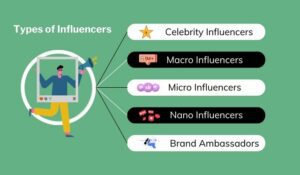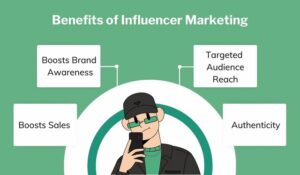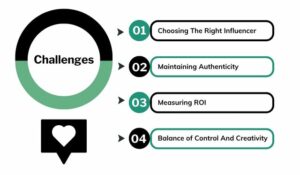Since its inception, influencer marketing has exponentially grown and is now the preferred method of marketing for several brands. With influencer marketing, you’re banking on the “influence” of a person (mostly a celebrity or someone of influence in their industry) and leveraging that popularity to promote a brand or product.
Brands invest millions of dollars annually toward influencer marketing wherein they promote their products on social media, like Instagram or TikTok in exchange for compensation (either through free products or payment).
But using influencer marketing does not guarantee success or conversion. First, you must understand what is influencer marketing and how you can use it to influence consumer behaviour and brand perceptions.
Let’s dive into the world of social media influencers and learn how to launch a successful influencer campaign. You’ll also learn how to integrate influencer marketing into your overall social media marketing plan.
What is Influencer Marketing: A Definitive Guide
Social media influencers are individuals on social media, such as Instagram or TikTok, who have gained a significant amount of following on their accounts. The strong online presence of a social media star attracts various brands that want to leverage their popularity to showcase their products to as many people as possible, especially their target market.
The idea behind building an influencer marketing campaign is that the loyal fans and followers of these influencers can impact consumer behaviour and perception of the brand. These are account owners who’ve built up a loyal and dedicated following within a specific niche or industry.
Due to their influence among their followers, most are up to millions in number, brands seek to work with their influencers via their social media platforms. These brands are banking on the social media influencer and their credibility and trustworthiness to make a positive impact on the brand.
Another reason that brands will want to work with a social media influencer is their targeted audience. This marketing tactic works to the brand’s advantage since they no longer have to do market research; they can tap the loyal following of the social media influencers to increase brand awareness and reach their marketing objectives.
However, there are several elements involved to build an effective influencer marketing strategy. It’s important to analyse these elements to ensure you succeed with your brand awareness campaigns.
Types of Influencers on Social Media
Creating a solid influencer marketing strategy requires more than just knowing what is influencer marketing. You must also recognise there are different types and characteristics, which could impact your influencer marketing strategy and budget.
Celebrity Influencers
Celebrity influencers are famous personalities or celebrities who attained fame for their skills or talents. Therefore, they also have a huge following on social media, as they’ve already reached celebrity status. Since they are celebrity influencers, their followers closely follow them and the products or services they use, which can increase your chances of brand exposure if you want to collaborate with these types of influencers.
Examples of celebrity endorsements are Our Place and Selena Gomez, NIKE and Serena Williams, and Chrissy Teigen and Blue Apron.
Macro Influencers
Macro influencers, also called mega influencers, on social media are those with a follower count of 100,000 to one million. These online influencers focus on a specific niche or industry, such as fitness or beauty influencers.
They are a popular choice for many brands seeking to get maximum exposure with a highly targeted audience.
Micro Influencers
Micro influencers are those who have 1,000 to 100,000 followers on social media. The lower follower count means you have a more engaged audience and it is common for the influencers themselves to interact with their followers in the comments.
Micro influencers are also a good choice for brands for their influencer campaigns, especially those that want to boost brand awareness and engagement.
Nano Influencers
Nano influencers are those with a smaller following on social media, ranging from 500 to 5,000. But these are loyal followers, so you should not overlook them for your influencer campaign. They may be small in numbers but can be highly engaged as they are hyper-targeted.
Brand Ambassadors
Brand ambassadors are those with a close relationship with the brand. These types of influencers work with a brand in more than just one project. They often have a long-term relationship and the ambassadors enjoy various perks from working with the brand.
Benefits & Challenges of Influencer Marketing
The role of influencer marketing has grown in recent years, particularly in helping with brand awareness so that companies can reach potential customers. To help reach your target audience, you must find influencers with a loyal following on social media that will generate influencer posts featuring your products or services.
However, it is like any marketing tool that has its benefits and challenges. Spend time learning about these benefits and challenges to come up with an effective influencer marketing strategy.
Benefits of Influencer Marketing
1. Boost Brand Awareness
Brand recognition is the primary benefit of using an influencer marketing campaign. Working with influencers can put your brand and products in front of people who may not have known about your brand, if not through social media posts. And if you’ve researched your influencers properly, you will be able to put your products in front of your influencer’s audience who might be the same as your ideal audience.
Needless to say, you are using the influencer’s social media channels and leveraging their popularity and credibility within a particular niche.
2. Targeted Audience Reach
As mentioned above, a major advantage of working with influencers is the opportunity to target your ideal audience. Influencers focus on a particular niche, such as beauty or fitness. Depending on your brand and its products or services, you can connect with these influencers since your products would appeal to a specific demographic that is part of their audience reach.
A targeted approach in your influencer marketing strategy ensures that your brand messaging reaches the right people.
3. Boost in Sales
If your marketing goal is to boost ROI, you can also leverage influencers to create content that will increase sales for your brand. If you choose mega influencers, they can convince their followers to purchase a particular product based on their positive reviews of the brand.
In turn, you can generate more sales for your products based on the influencer’s opinion, especially since their followers value their opinion. These followers also have a belief that these influencers don’t promote products they won’t otherwise use.
4. Authenticity
Influencers, especially macro influencers, scrutinise the brands before they agree to work on an influencer marketing campaign. They need to vet the brands they work with closely as they don’t want to hurt their reputation as an influencer.
This works to the brand’s advantage since it boosts the authenticity of the posts and the influencer campaign, making it more credible. According to a 2020 Nielsen Consumer Trust Index report, 92% of consumers prefer buying products recommended by influencers versus traditional advertising.
Challenges of Influencer Marketing
While there are clear benefits, you must be aware of the challenges involved in setting up a successful campaign.
1. Choosing the Right Influencers
There are many influencers out there and the challenge lies in choosing the right fit for your influencer campaigns. Not all influencers would be perfect for your brand, even if they have a huge following. In fact, it is not a smart strategy to pick social influencers based on the number of followers. Many followers have fake followers, while some buy followers to increase their numbers.
You must be careful in choosing key performance indicators to guide your choice of the right influencer to work with. The choice of influencer must be aligned with your brand values to increase authenticity.
2. Maintaining Authenticity
Authenticity is part of the reason why influencer marketing has been so successful, and why many brands and marketers choose this over traditional advertising. You must do extensive research to ensure you only work with influencers who genuinely support your brand, or whom you share values with.
It can be difficult to discern if an influencer is only after the compensation, or the perks of the brand partnership.
3. Measuring ROI
Measuring the result of an influencer campaign and its ROI can be challenging. Since any sales generated from the partnership with an influencer is not direct (except for those partnerships which involve a custom code or tracking links), it can be hard to measure success and the ROI from the investments made for the influencer campaign.
That’s why it is important to set metrics and goals at the start of each campaign so you can analyse them later.
4. Balance of Control and Creativity
Working with influencers can be a delicate balance between making sure they follow the brief and giving them creative freedom. It is one area where brands struggle the most. For brands, they want to control the messaging to a certain extent to ensure that they push their campaign goals forward.
But you must recognise the fine line between guiding your influencers on how to produce content and them losing their voice in the creation process. If you end up with the latter, the collaboration loses its authenticity and it becomes ineffective as a whole.
Strategies for Successful Influencer Marketing Campaigns
Employing an influencer marketing strategy for increasing brand awareness is not guaranteed. Like any marketing tactic, not all campaigns will succeed. You need to be researching influencers in your niche or industry to make sure the influencer’s audience is aligned with your brand vision and your ideal audience. That’s why most brands fail in using influencers because they are not properly matched for what the organisation needs to use as ambassadors on social media.
Too often, brands focus too much on vanity metrics, such as how many followers an influencer has. If you use this approach, your marketing efforts will fail because you don’t consider the brand values and if your social influencers can have the right set of dedicated followers you want to target.
Therefore, you must be strategic if you choose to employ an influencer program as part of your marketing campaigns. These are the best strategies that you can use to maximise brand awareness campaigns and make your marketing dollars pay off.
1. Identify Your Marketing Goals & Audience
You cannot launch your influencer marketing campaign without two things: marketing goals and target audience.
These two components will serve as the foundation for your influencer campaign activities. If you don’t know your goals and audience yet, you need to ask the following questions:
- What is your goal for the influencer campaign? Do you want to increase brand awareness or boost ROI? Do you have a new product launch that you want to get publicity for?
- Who is your target audience? What is their age or demography?
- If you want to increase ROI or brand recognition, who is the right influencer for the campaign? Do you want to work with a social media influencer that has more followers or those with a higher engagement?
- Which social media do you want to prioritise for your influencer marketing campaign? Is it Instagram or TikTok? Where is your target audience mostly on social media?
Answering these questions will enable you to have a clear focus on what you want to achieve and align that with the ideal influencer that can help you make the most of your campaign.
2. Find the Best Influencer for the Campaign
The meaning of “best” refers to the influencer who is a perfect match for your idea of the ideal brand ambassador. For example, if you are a yoga studio in Los Angeles, your ideal ambassadors would be those female yoga and fitness influencers based in Los Angeles or California. These influencers can use their influencer content to generate buzz about your yoga studio.
If you’ve done your research right, you can produce branded content with the help of your partner influencer to get your content out to the target consumers (potentially women who are also into yoga and fitness in the LA area). You should spend time finding the specific influencer that aligns with your brand’s values. If not, it could hurt your brand’s reputation instead of helping generate interest for your yoga studio.
A successful influencer marketing campaign is a lot like social media marketing. You must leverage the loyal fan base of your potential influencers to boost brand awareness. However, it is only effective if it is authentic and you can find the ideal match for your campaign.
3. Build Relationships with Influencers
Once you have identified a list of potential influencers to help with your marketing campaigns, the next step is to establish a relationship with them. It’s not ideal to make your first contact with a social media influencer about working on a campaign. You must first establish trust and mutual respect, so they are more likely to want to work with you.
Start by looking at the influencer’s profile. Is their audience the same as your target market? Then, look at the influencer content. Make sure the content quality aligns with your brand and that your products or services fit naturally into the current type of content they are already producing on their feed.
If you don’t do the steps above, it will seem unnatural to their audience if they promote your brand or products that don’t blend with the past influencer posts. The branded content would strike the audience as irrelevant or purely marketing instead of being a “personal recommendation.”
At this point, you can reach out to the social media influencer on their preferred social media platforms. Practice transparency about what you’re looking for in a partnership. Let them know what you offer them in exchange for branded content. Some social media influencers openly express what they want from brand partners, such as free products or monetary compensation, or both.
4. Write a Clear Brief
A brief is an essential component of a successful social influencer campaign. You can send the brief once the influencer has expressed interest in being a part of your campaign. In the brief, include the campaign objectives and key messaging.
For example, if you are a food brand, you want the key message to be how the brand maintains supply chain transparency and focuses on sustainable sourcing practices. You must be as clear as possible on your expectations to provide guidance for the influencers when they produce content for their dedicated followers.
If you’re working on a time-sensitive campaign, such as you’re planning to release social media content before the launch date of a new product, include that in the brief. It will help your influencers to plan their content creation according to your timeline.
5. Give Influencers Creative Freedom
The social media brief for social media content marketing only serves as a guideline. Make sure to give your influencers the creative freedom to develop content that fits the aesthetic of their feed and the following base.
This is why researching influencers to work with is a crucial process. You must choose your influencers to partner with that matches your brand so that you can give them the freedom to create content that is authentic to them, making an even bigger impact on your ideal customers.
6. Analyse Results
At the start of your influencer marketing campaign, you must identify key performance indicators (KPIs). You can use these KPIs to measure the success of your marketing campaigns using actual data, such as the number of website visits, new followers gained, and engagement level. The KPIs will differ from one campaign to another based on the established goals.
Some brands pay a bonus on top of the compensation given to most influencers, as an added motivation to help them build authentic content and generate more engagement.
Another reason to measure and analyse the results of your influencer marketing campaign is that it will inform your future strategies. You can use the data to determine where you can improve in future collaborations with influencers. It is also a crucial step if you’re planning to build a long-term partnership with influencers in your extensive network.
7. Maintain Influencer Relationships
Even after the influencer marketing collaboration is over, you should still build a relationship with your influencers. Maintaining a relationship with them is essential so that your partnership feels like a genuine collaboration, and their target audience (and yours) can see that. Another way to build a relationship with the influencer is to support their content, even if it’s not your own branded campaign.
Knowing what is influencer marketing and the best strategies to employ for successful influencer campaigns go hand in hand. Increased brand awareness happens as a result of building an extensive network of influencers that will serve as ambassadors for your online brand.
Key Takeaways on Influencer Marketing
Influencer marketing works! It is a powerful way to reach a target social media audience through influencer campaigns. You can leverage the popularity of influencers to reach a broad audience, especially those who might not even be aware that your brand exists. When done correctly, it can be a potent part of your comprehensive social media marketing strategy.
Take note of the essential factors in a powerful influencer marketing campaign, such as choosing the right influencers to work with and aligning the messaging to fit your brand. Authenticity is also important, so make sure to give your influencers creative freedom to create content that resonates with their audience for maximum impact.














Leave a Comment